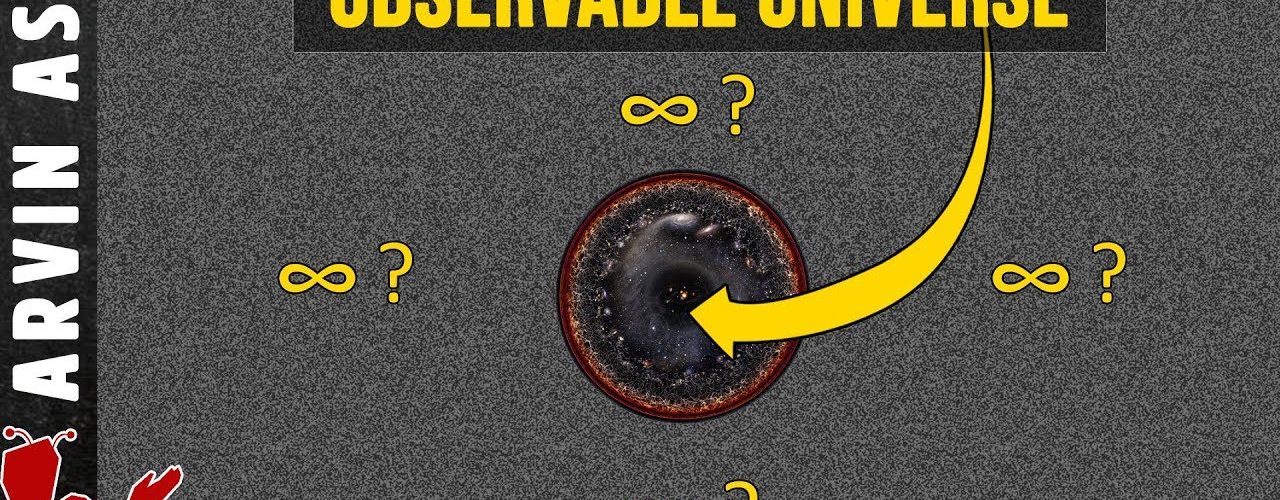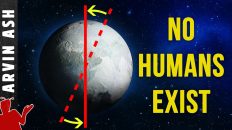Large largest Scales of the universe, Is the universe infinite? Visualizing infinity
This video is collaboration with a great channel called Beautiful Science. If you haven’t seen it, check it out. My friend Chris makes short science videos using really cool animations. And if you are coming here from the Beautiful science channel, welcome!
This is a video about some of the largest sizes and numbers in the universe.
In a previous video, we looked at the smallest scales. We attempted to visualize the smallest size in the universe, the Planck length, which is about 1.6 x 10^-35 meters. This is so small that If an atom was the size of the earth, the Planck length would be smaller than a proton.
But the large scale size of the universe is equally mind blowing. For example if the Sun was the size of a Basketball, how far do you think the nearest star Proxima Centauri, our neighbor, would be?
Would it be on the other end of the basketball court. Would it be further, like maybe a mile away, maybe 10 miles away. Take a wild guess. You would have to keep going much farther. If you were playing basketball in New York City, our neighbor Proxima Centauri would be about 4500 hundred miles away, on a basketball court somewhere in Moscow.
And there are 10 sextillion such stars in the universe that is 1 followed by 22 zeros. And each one of them is approximately the same distance apart from each other as proxima centauri is from the sun.
In fact, the universe is bigger than even what our most powerful telescopes can see. How big is the universe in terms of numbers? And in fact, could it be infinite? Is there any way we can even begin to visualize what infinity is? We just might be able to it. How?
Let’s start with genius animations created by Cary and Michael Huang, who have generously given us permission to use them. The link to their website is in the description below.
We’ll start with the scale of a human being, and work our way up, because it helps to start with something relatable. And the size of your body should be the most relatable scale – about 1-3 meters. These would be objects like a bicycle or a sunflower bloom.
If we go a hundred times bigger, to about 100 meters, we will be at the scale of a Boeing 747 jet or the size of an American Football field.
Let’s go 1000 times bigger than the scale of humans. About 1000 meters. Now we are looking at the tallest building in the world – Burj Khalifa – 830 meters. Also Vatican City is only about 1 kilometer in length.
Let’s go 1000 times bigger than this, 1 million meters. Now we are on the scale of California and Italy both of which are about 1200 km in length. We also begin to approach now, some of the smallest spherical celestial bodies. The former smallest planet Pluto which is about 2300km in diameter. Pluto was reclassified in 2006, to the protest of many people, to be designated a lowly dwarf planet.
Let’s go 1000 times larger than this scale, or one billion meters, we will now be going way past the size of the earth, which is only about 12,742 kilometers in diameter. And we are passing even the size of Jupiter which is more than 10 times larger in diameter than earth – about 140,000 km, or 140 million meters. Jupiter is actually only slightly smaller than our nearest star neighbor Proxima Centauri which is only about 215,000 km in diameter, much smaller than our sun. which is about 1.4 million km, or 1.4 billion meters.
Let’s go 1000 times larger than the size of the sun or one trillion meters. Now we are looking at some of the largest and brightest stars that we can see in the milky way galaxy. Stars like Betelgeuse, a red supergiant, the 9th brightest star in the sky, which is 1.2 billion km in diameter. One of the brightest stars in the sky is also the largest known star in the Milky Way galaxy, VY Canis Majoris at about 2 billion km in diameter.
Let’s go 1000 times larger than this or 1 quadrillion meters. We will be passing by the oort cloud which is thought be a spherical shell comsisting of up to 2 trillion comets that surround the solar system. This is where an occasional gravitation disturbance can send a comet hurtling towards the sun, or more ominously, towards the earth. This spherical cloud starts about 1 trillion kilometers away from the sun and ends about 15 trillion km away from the sun. This also forms the outer boundary of our solar system, where the gravitational influence of the sun is minimal to non-existent.
Now we are at the scale of a light year which is about 9.4 quadrillion meters or 9.4 trillion kilometers.
Let’s go 1000 times larger than this, or 1 quintillion meters. This is about 100 light years. Now we can talk in terms of the scale of our galaxy, the Milky Way galaxy.
We are going to go past the size of some of the most spectacular structures in the universe, like the pillars of creation and the eagle nebula,
As well as some of the smaller galaxies that surround our milky way galaxy.
Our galaxy is about 106,000 light years across, or almost exactly 1 quintillion kilometers or 1 X 10^21 meters, containing anywhere from 250 billion to 400 billion stars. Other than the fact we live here, there is nothing particularly remarkable about our galaxy. It is a typical spiral galaxy. There are billions of others like it in the universe. Our neighbor the Andromeda galaxy is larger, containing 1 trillion stars.
When we go 1000 times larger than this, we begin to see the super structure of the universe which is made up of superclusters. We live in such a structure called the virgo superstructure. It also contains Andromeda and about 100 other galaxies. It is about 110 million light years in diameter, or 10^21 or 1 sextillion kilometers across. There are estimated to be about 10 million superclusters in the universe.
When we go 1000 times larger than this, we reach the end of the visible universe at about the scale of 10^27 meters. The observable universe has a diameter of about 93 billion light years or 1 x 10^27 meters.
How is it that the universe is only 13.8 billion years old, but is 93 light years across? Shouldn’t it be 13.8 billion light years across if nothing can travel faster than light? That’s a great question because this is pretty confusing.
First 13.8 billion years would the be the radius of a sphere, so the diameter would be twice that or 27.6 billion light years. This is basically what we see in the WMAP or the universe’s microwave background photo. In fact each of the red bumps you see on this photo has evolved into a superclusters that I talked about earlier.
But the reason it is actually 93 billion light years across and not 13.8 billion light years is because the universe has been expanding for the entire 13.8 billion years, and due to the doppler effect, we know that the farther away an object is, the faster it is moving away from us. And we can calculate that those superclusters of galaxies, based on the expansion of the universe would be 46.5 billion light years from us by this time.
That’s the radius, so the diameter of the universe would be twice that or 93 billion light years across.
In fact, if we waited 46.5 billion years, we would be able to see the light emitted right now from those superclusters because the light would have started on its way to us right now, and would take 46.5 billion years to get here.
But we will actually never eventually see this light because in 1998, we discovered something dark energy, and learned that universe is not in a steady expansion, but rather an accelerating expansion, so that light will be receding from us at greater than the speed of light.
But isn’t the speed of light the cosmic speed limit? Yes, for things travelling within space. But there is no limit on the expansion of space itself. The space between galaxies is expanding faster than light. The galaxies are not travelling within space faster than light.
But could it be though that what we see can see is a miniscule portion of a universe that is actually infinite?
Is there any way to determine whether the universe could be infinite? Well, the cosmic microwave background gives us a clue. It’s the leftover glow from the big bang. Although it looks fairly uniform, there is a lot of information there.
One of the things that this microwave background tells us is that the universe appears to be flat. How do we know this? Scientists look for what we would see if the universe was a certain shape.
They look for the curvature of space. If space was not flat but positively curved like a 4 dimensional sphere, then we would expect to see multiple images of the same object in the sky because distant light rays would diverge. This is like ants on a balloon trying to measure the flatness of their 2D universe by adding up the angles in a triangle to make sure they add up to 180 degrees. In a positively curved universe, the angles would add up to greater than 180 degrees.
Likewise distant light rays would converge if we lived in a negatively curved space shaped like a saddle. And the angles would add up to less than 180 degrees.
Data from the WMAP as well as Planck spacecraft, however, indicates that the universe is flat, or nearly flat with an error of 0.4%. A flat universe would be an infinite universe. But if the error is taken into account, then it is possible that the universe could have a slightly positive curvatire. In that case it would be finite, but would have to have a radius at least 250 times larger than the part that we can see. This would be a minimum size of (250 x 46.5==11.6) 11.6 trillion light years in radius or about 23 trillion light years in diameter, instead of the 93 billion that we can see.
This is huge, but would be much smaller than infinity. Infinity is a very large number. Imagine a very large number like a googol, the real googol, spelled differently than what you are used to seeing. This is 10^100 light years. That’s 1 following by 100 zeros.
Or a googolplex which is 10^10^100 – that’s 10 to the google power. An extremely large number. Much larger than even the number of planck volumes that would fit inside the observable universe (4.7 x10^185 planck volumes could fit inside the universe). But infinity is much much larger than either of those numbers. It goes on forever after all.
Imagine the earth being a perfect sphere, and an ant trying to figure out its curvature by drawing large triangles and seeing if the angles added up to 180. It may conclude that the earth is flat.
So our universe appears to be consistent with a flat universe, although we can not rule out a curved universe. So our best guess right now is that the universe is infinite. But infinities in science tend to be due to errors, so we should be skeptical about this result.
What we do know for sure is that universe is much larger than the part we can observe. The problem is we only have access to the information contained our in our tiny 93 billion light year diameter bubble that we call the observable universe. We can only infer from what we can see.
This is like a sailor on a boat in the open sea, in the middle of the Pacific ocean at night, trying to figure out where the ocean ends, with nothing but the stars to guide him.







